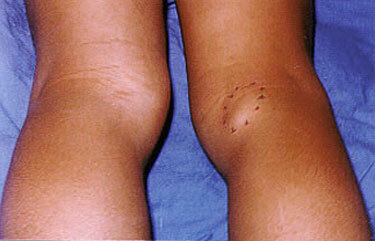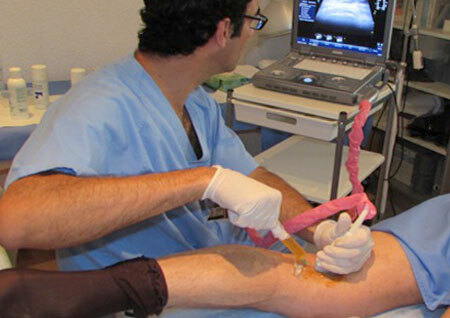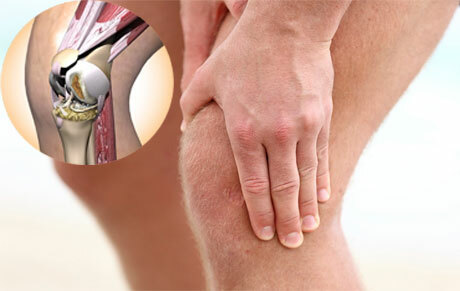Some inflammatory diseases of the knee joint lead to the accumulation of fluid in the interstitial bag and the formation of Becker's cyst under the knee. How to treat this disease, what are its causes, signs and complications? The answers to these questions are presented below.
Contents of
- 1 Cyst Becker - what is it?
- 2 Signs and symptoms of cysts, photo
- 3 How to treat Becker's cyst?
- 4 Complications after Becker's cyst
- 5 Preventive measures
Cyst Becker - what is it?
Another name for the disease is a hernia or bursitis of the popliteal fossa. The knee cyst of Becker develops in a bag located between the tendons of the semimembranous and gastrocnemius muscles.
It is formed with a significant accumulation of synovial fluid due to trauma or prolonged inflammation in the joint tissues. The cyst restricts mobility in the knee, causing pain when moving.
It is better to understand that this is what the general scheme will help: joint movements are provided by elastic cartilaginous tissue, ligamentous apparatus and synovial fluid. The latter works as a lubricant, reducing friction and circulating throughout the joint surface.

Cyst of Becker under the knee, photo and diagram of
A certain amount of it penetrates the tendon area. If its volume increases, then it accumulates in the interweaving bag - so Becker's cyst appears.
Code in ICD 10( International Classification of Diseases) - M71.2 - Popliteal synovial cyst [Becker]
The primary cause of education is pathology in the knee joint, for example:
- arthritis, in particular rheumatoid arthritis;
- gonarthrosis;
- knee injury, accompanied by cartilage damage;
- osteoarthritis - almost half of the cases lead to pathology;
- is an inflammation of the meniscus.
The inflammatory process is accompanied by the formation of a pathological exudate, which also penetrates into the interstitial popliteal bag.
Signs and symptoms of cysts, photos

Kista Becker photo
At the first stages of development, the popliteal bursa does not manifest itself. Increasing in volume, the cyst leads to the fact that it is difficult to unbend the leg in the knee, and when palpation a painful and dense formation is felt. Later the bag filled with a liquid delivers a pain and in a rest position, and at attempt of movement painful sensations amplify.
An additional symptom of Becker cysts is a feeling of numbness or tingling in the foot due to the fact that the nerves passing to the heel of the knee are squeezed.
To identify the presence of hernia popliteal fossa allow such methods of examination:
- ultrasound of the knee joint and adjacent areas;
- MRI - shows the structure of tissues "in a cut", from different sides;
- arthroscopy is a minimally invasive way of examining articular and tendon elements. It is performed under local anesthesia by inserting a micro-chamber through a small hole.
Radiography for the diagnosis of the Becker cyst is not applied, since it does not detect such formations.
How to treat Becker's cyst?

Treatment of Becker's cyst can be conservative or surgical. In the first case, drainage is performed - the hernia is punctured and the contents are removed through a catheter. To stop the inflammatory process, medications are injected into the cyst cavity:
- corticosteroids( Diprospan, Dexamethasone, Kenalog);
- NVPs( Indomethacin, Ketoprofen, Ibuprofen).
Spasmolytics are also used to relieve muscle pain and tension( Diazepam).After drainage, the patient wears elastic bandages, knee pads until the joint is fully restored, which takes 10-15 days.
In passing, there is a therapy of the main pathology that caused the development of cyst - arthritis, arthrosis or other disease. The level of physical activity should be reduced, microcurrents, magnetotherapy and other methods of physiotherapy are useful.
Operational removal of the Becker cyst is indicated if:
- hernia compresses nerve fibers and blood vessels;
- is low or lacks the effect of conservative treatment;
- the size of the cyst is large or there is a chronic cystic tumor.
Surgical treatment is performed under local anesthesia, during the operation of the Becker cyst is stretched and removed. To do this, use an arthroscope or an endoscope - that is, intervention is minimally invasive.
For complete relief of the pathological process, it is important to eliminate the cause of the formation of a hernia popliteal fossa. For example, surgery may be required to restore cartilage.
Folk treatment of Becker's cysts makes sense only in complex therapy with small hernia sizes. Many plants help to relieve pain and reduce inflammation:
- Birch buds, herb, mint, plantain, nettle and cowberry leaves are mixed in the same parts, and every day take an infusion prepared from 1 tbsp.l.collection and 200 ml of boiling water.
- Compress on the popliteal area of a multi-layer gauze dipped in an alcohol tincture of a golden mustache or in a decoction of spice cloves and dandelions.
- Leaf the cabbage and put it on a sour place, wrapped with polyethylene and a warm cloth.
Consider traditional medicine recipes as the main treatment is unacceptable.
Complications after Becker's cyst
Herniated popliteal fossa without timely treatment can lead to complications, among them:
- Venous congestion and swelling in the shin and foot area, in severe cases the appearance of non-healing, wet, trophic ulcers on the limb.
- Breaking the Becker cyst and penetrating the synovial and inflammatory fluid into the ankle tissue leads to acute pain, swelling and redness of the skin and requires immediate medical attention.
- Thrombosis and inflammation of the venous walls, which is fraught with the severance of the thrombus and its entry into vital organs. Especially dangerous is the obstruction of the pulmonary artery, leading to instantaneous death.
- Necrosis of muscles, osteomyelitis, sepsis due to impaired blood supply to tissues.
Preventive measures
Prophylaxis of Becker's cyst is as follows:
- Treatment of diseases of the knee joint.
- Caution when playing sports, protecting knees from injuries with treads.
- Periodic courses of chondroprotectors, especially after 40 years, which is aimed at preserving the cartilaginous tissue.
- Elimination of infections present in the body.
If you find pain and discomfort in the popliteal region, do not hesitate to visit a doctor - this is the key to successful treatment and the absence of dangerous complications.



